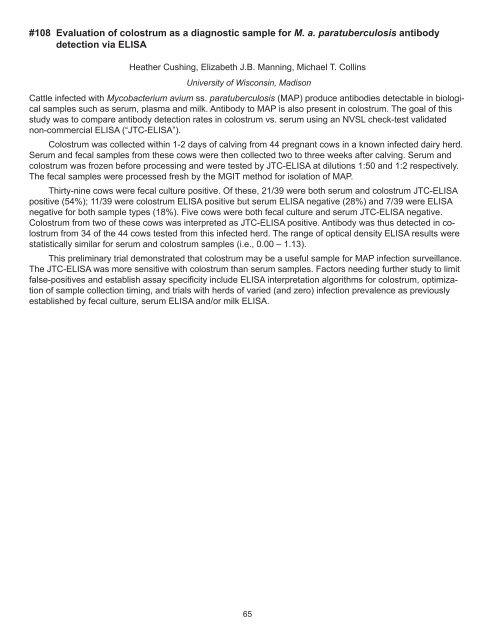Proceedings of the 10th International Colloquium on Paratuberculosis
Proceedings of the 10th International Colloquium on Paratuberculosis
Proceedings of the 10th International Colloquium on Paratuberculosis
Create successful ePaper yourself
Turn your PDF publications into a flip-book with our unique Google optimized e-Paper software.
#108 Evaluati<strong>on</strong> <str<strong>on</strong>g>of</str<strong>on</strong>g> colostrum as a diagnostic sample for M. a. paratuberculosis antibody<br />
detecti<strong>on</strong> via ELISA<br />
Hea<str<strong>on</strong>g>the</str<strong>on</strong>g>r Cushing, Elizabeth J.B. Manning, Michael T. Collins<br />
University <str<strong>on</strong>g>of</str<strong>on</strong>g> Wisc<strong>on</strong>sin, Madis<strong>on</strong><br />
Cattle infected with Mycobacterium avium ss. paratuberculosis (MAP) produce antibodies detectable in biological<br />
samples such as serum, plasma and milk. Antibody to MAP is also present in colostrum. The goal <str<strong>on</strong>g>of</str<strong>on</strong>g> this<br />
study was to compare antibody detecti<strong>on</strong> rates in colostrum vs. serum using an NVSL check-test validated<br />
n<strong>on</strong>-commercial ELISA (“JTC-ELISA”).<br />
Colostrum was collected within 1-2 days <str<strong>on</strong>g>of</str<strong>on</strong>g> calving from 44 pregnant cows in a known infected dairy herd.<br />
Serum and fecal samples from <str<strong>on</strong>g>the</str<strong>on</strong>g>se cows were <str<strong>on</strong>g>the</str<strong>on</strong>g>n collected two to three weeks after calving. Serum and<br />
colostrum was frozen before processing and were tested by JTC-ELISA at diluti<strong>on</strong>s 1:50 and 1:2 respectively.<br />
The fecal samples were processed fresh by <str<strong>on</strong>g>the</str<strong>on</strong>g> MGIT method for isolati<strong>on</strong> <str<strong>on</strong>g>of</str<strong>on</strong>g> MAP.<br />
Thirty-nine cows were fecal culture positive. Of <str<strong>on</strong>g>the</str<strong>on</strong>g>se, 21/39 were both serum and colostrum JTC-ELISA<br />
positive (54%); 11/39 were colostrum ELISA positive but serum ELISA negative (28%) and 7/39 were ELISA<br />
negative for both sample types (18%). Five cows were both fecal culture and serum JTC-ELISA negative.<br />
Colostrum from two <str<strong>on</strong>g>of</str<strong>on</strong>g> <str<strong>on</strong>g>the</str<strong>on</strong>g>se cows was interpreted as JTC-ELISA positive. Antibody was thus detected in colostrum<br />
from 34 <str<strong>on</strong>g>of</str<strong>on</strong>g> <str<strong>on</strong>g>the</str<strong>on</strong>g> 44 cows tested from this infected herd. The range <str<strong>on</strong>g>of</str<strong>on</strong>g> optical density ELISA results were<br />
statistically similar for serum and colostrum samples (i.e., 0.00 – 1.13).<br />
This preliminary trial dem<strong>on</strong>strated that colostrum may be a useful sample for MAP infecti<strong>on</strong> surveillance.<br />
The JTC-ELISA was more sensitive with colostrum than serum samples. Factors needing fur<str<strong>on</strong>g>the</str<strong>on</strong>g>r study to limit<br />
false-positives and establish assay specificity include ELISA interpretati<strong>on</strong> algorithms for colostrum, optimizati<strong>on</strong><br />
<str<strong>on</strong>g>of</str<strong>on</strong>g> sample collecti<strong>on</strong> timing, and trials with herds <str<strong>on</strong>g>of</str<strong>on</strong>g> varied (and zero) infecti<strong>on</strong> prevalence as previously<br />
established by fecal culture, serum ELISA and/or milk ELISA.<br />
65






